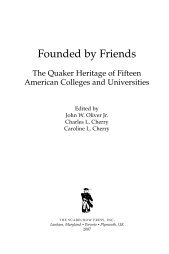Separate Realities: The Dream and the Iceberg - Scarecrow Press
Separate Realities: The Dream and the Iceberg - Scarecrow Press
Separate Realities: The Dream and the Iceberg - Scarecrow Press
Create successful ePaper yourself
Turn your PDF publications into a flip-book with our unique Google optimized e-Paper software.
60 Chapter 2<br />
plans fell from 84 percent in 1980 to 50 percent in 1997. For workers in small<br />
firms, such coverage declined from 20 percent in 1990 to 15 percent in 1996. 70<br />
In 1995 <strong>the</strong> proportion of workers covered by defined-contribution pension<br />
plans exceeded <strong>the</strong> proportion covered by defined-benefit plans. Since <strong>the</strong>n,<br />
<strong>the</strong> proportion of workers covered by defined-benefit plans has continued to<br />
decline, while <strong>the</strong> proportion covered by defined-contribution plans has continued<br />
to increase. 71 In 2005 about 21 percent of all private-sector workers had<br />
access to, <strong>and</strong> were participating in, defined-benefit pension plans; by contrast,<br />
53 percent of private-sector workers had access to defined-contribution<br />
pension plans, but only 42 percent were participating in such plans. 72 Given<br />
<strong>the</strong> important differences between <strong>the</strong> two types of pension plans, it is clear<br />
that “<strong>the</strong> shift from traditional defined-benefit plans to defined-contribution<br />
plans represents an erosion of pension quality.” 73<br />
Regarding health care, <strong>the</strong> share of private-sector wage <strong>and</strong> salary workers<br />
covered by employer-provided health-care plans, where employers pay<br />
amounts ranging from partial to full premiums, declined from 69 percent of<br />
private-sector workers in 1979 to 55.9 percent in 2004. This trend affects workers<br />
in all gender <strong>and</strong> racial categories. From 1979 to 2004, health-care coverage<br />
fell for male workers from 75.4 to 58.7 percent <strong>and</strong> from 59.4 to 52.5 percent<br />
for female workers. During <strong>the</strong> same period, coverage for whites fell from<br />
70.3 to 59.8 percent; black health-care coverage dropped from 63.1 to 54.1<br />
percent, <strong>and</strong> coverage for Hispanics fell from 60.4 to 39.7 percent. 74<br />
In parallel with declining health-care coverage were increased premium<br />
costs for workers, <strong>and</strong> increased percentages of workers were required by employers<br />
to help fund <strong>the</strong>ir health-care plans. <strong>The</strong> increase in health-care premiums<br />
paid by workers for family-coverage medical care rose (in 2006 dollars)<br />
from an average of $155 per month in 1996 to $172 per month in 1999 to<br />
$226 in 2006. 75 <strong>The</strong> proportion of full-time private-sector workers required to<br />
make contributions for single medical coverage increased from 26 percent in<br />
1980 to 69 percent in 1997 to 76 percent in 2004; for family medical coverage,<br />
<strong>the</strong> percentage of workers required to make contributions increased from<br />
46 percent in 1980 to 80 percent in 1997 to 89 percent in 2004. 76<br />
Growing Contingent Work<br />
Workers’ wages <strong>and</strong> benefits fell in part due to <strong>the</strong> growing use by employers<br />
of more non-full-time workers to reduce labor costs. <strong>The</strong> alternatives to<br />
full-time employment include a number of work arrangements variously referred<br />
to by researchers <strong>and</strong> journalists as “contingent” or “nonst<strong>and</strong>ard”<br />
work. 77 Despite <strong>the</strong> lack of comprehensive trend data on contingent work, different<br />
forms of information suggest that employers are employing more workers<br />
outside of full-time work arrangements. 78 Today, “over a quarter of all<br />
workers [are] now working at jobs that are contingent or nonst<strong>and</strong>ard.” 79 This
















